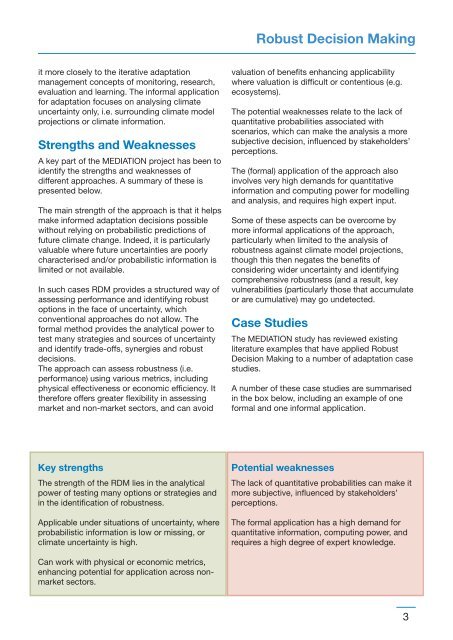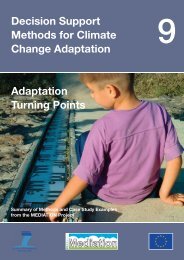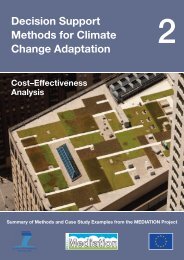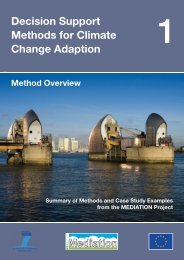Download all Technical Policy Briefing Notes in a single ... - Mediation
Download all Technical Policy Briefing Notes in a single ... - Mediation
Download all Technical Policy Briefing Notes in a single ... - Mediation
- No tags were found...
You also want an ePaper? Increase the reach of your titles
YUMPU automatically turns print PDFs into web optimized ePapers that Google loves.
Robust Decision Mak<strong>in</strong>git more closely to the iterative adaptationmanagement concepts of monitor<strong>in</strong>g, research,evaluation and learn<strong>in</strong>g. The <strong>in</strong>formal applicationfor adaptation focuses on analys<strong>in</strong>g climateuncerta<strong>in</strong>ty only, i.e. surround<strong>in</strong>g climate modelprojections or climate <strong>in</strong>formation.Strengths and WeaknessesA key part of the MEDIATION project has been toidentify the strengths and weaknesses ofdifferent approaches. A summary of these ispresented below.The ma<strong>in</strong> strength of the approach is that it helpsmake <strong>in</strong>formed adaptation decisions possiblewithout rely<strong>in</strong>g on probabilistic predictions offuture climate change. Indeed, it is particularlyvaluable where future uncerta<strong>in</strong>ties are poorlycharacterised and/or probabilistic <strong>in</strong>formation islimited or not available.In such cases RDM provides a structured way ofassess<strong>in</strong>g performance and identify<strong>in</strong>g robustoptions <strong>in</strong> the face of uncerta<strong>in</strong>ty, whichconventional approaches do not <strong>all</strong>ow. Theformal method provides the analytical power totest many strategies and sources of uncerta<strong>in</strong>tyand identify trade-offs, synergies and robustdecisions.The approach can assess robustness (i.e.performance) us<strong>in</strong>g various metrics, <strong>in</strong>clud<strong>in</strong>gphysical effectiveness or economic efficiency. Ittherefore offers greater flexibility <strong>in</strong> assess<strong>in</strong>gmarket and non-market sectors, and can avoidvaluation of benefits enhanc<strong>in</strong>g applicabilitywhere valuation is difficult or contentious (e.g.ecosystems).The potential weaknesses relate to the lack ofquantitative probabilities associated withscenarios, which can make the analysis a moresubjective decision, <strong>in</strong>fluenced by stakeholders’perceptions.The (formal) application of the approach also<strong>in</strong>volves very high demands for quantitative<strong>in</strong>formation and comput<strong>in</strong>g power for modell<strong>in</strong>gand analysis, and requires high expert <strong>in</strong>put.Some of these aspects can be overcome bymore <strong>in</strong>formal applications of the approach,particularly when limited to the analysis ofrobustness aga<strong>in</strong>st climate model projections,though this then negates the benefits ofconsider<strong>in</strong>g wider uncerta<strong>in</strong>ty and identify<strong>in</strong>gcomprehensive robustness (and a result, keyvulnerabilities (particularly those that accumulateor are cumulative) may go undetected.Case StudiesThe MEDIATION study has reviewed exist<strong>in</strong>gliterature examples that have applied RobustDecision Mak<strong>in</strong>g to a number of adaptation casestudies.A number of these case studies are summarised<strong>in</strong> the box below, <strong>in</strong>clud<strong>in</strong>g an example of oneformal and one <strong>in</strong>formal application.Key strengthsThe strength of the RDM lies <strong>in</strong> the analyticalpower of test<strong>in</strong>g many options or strategies and<strong>in</strong> the identification of robustness.Applicable under situations of uncerta<strong>in</strong>ty, whereprobabilistic <strong>in</strong>formation is low or miss<strong>in</strong>g, orclimate uncerta<strong>in</strong>ty is high.Potential weaknessesThe lack of quantitative probabilities can make itmore subjective, <strong>in</strong>fluenced by stakeholders’perceptions.The formal application has a high demand forquantitative <strong>in</strong>formation, comput<strong>in</strong>g power, andrequires a high degree of expert knowledge.Can work with physical or economic metrics,enhanc<strong>in</strong>g potential for application across nonmarketsectors.3





